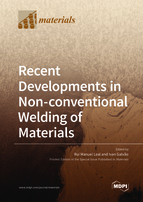Recent Developments in Non-conventional Welding of Materials
A special issue of Materials (ISSN 1996-1944).
Deadline for manuscript submissions: closed (15 December 2020) | Viewed by 35662
Special Issue Editors
2. CEMMPRE, Department of Mechanical Engineering, University of Coimbra, Rua Luís Reis Santos, 3030-788 Coimbra, Portugal
Interests: welding technology; processing technology; microstructural and mechanical characterization; friction stir welding; explosion welding
Special Issues, Collections and Topics in MDPI journals
2. CEMMPRE, Department of Mechanical Engineering, University of Coimbra, Rua Luís Reis Santos, 3030-788 Coimbra, Portugal
Interests: solid-state welding; friction stir welding; explosion welding; dissimilar materials welding; solid-state processing
Special Issues, Collections and Topics in MDPI journals
Special Issue Information
Dear Colleagues,
Welding is one of the technological fields with the greatest impact in many industries, such as automotive, aerospace, energy production, electronics, the health sector, etc. Welding technologies are currently used to join the most diverse materials, from metallic alloys to polymers, composites, or even biological tissues. Despite the relevance and wide application of traditional welding technologies, these processes do not meet the demanding requirements of some industries. This has driven strong research efforts in non-conventional welding processes, such as laser welding, ultrasonic welding, impact welding, friction stir welding, diffusion welding, and many other welding technologies. Important studies have been recently developed all over the world on the application of these processes to the joining of cutting-edge materials and material combinations, enabling the production of joints with improved properties. Thus, this Special Issue will present the most recent developments in the non-conventional welding of materials. Experimental and numerical modelling/simulation research on all aspects related to this multidisciplinary subject are welcome. Original research and review papers addressing innovative developments in non-conventional welding processes and process applications are valuable scientific contributions.
We look forward to receiving your contributions to this issue.
Prof. Dr. Rui Manuel Leal
Prof. Dr. Ivan Galvão
Guest Editors
Manuscript Submission Information
Manuscripts should be submitted online at www.mdpi.com by registering and logging in to this website. Once you are registered, click here to go to the submission form. Manuscripts can be submitted until the deadline. All submissions that pass pre-check are peer-reviewed. Accepted papers will be published continuously in the journal (as soon as accepted) and will be listed together on the special issue website. Research articles, review articles as well as short communications are invited. For planned papers, a title and short abstract (about 100 words) can be sent to the Editorial Office for announcement on this website.
Submitted manuscripts should not have been published previously, nor be under consideration for publication elsewhere (except conference proceedings papers). All manuscripts are thoroughly refereed through a single-blind peer-review process. A guide for authors and other relevant information for submission of manuscripts is available on the Instructions for Authors page. Materials is an international peer-reviewed open access semimonthly journal published by MDPI.
Please visit the Instructions for Authors page before submitting a manuscript. The Article Processing Charge (APC) for publication in this open access journal is 2600 CHF (Swiss Francs). Submitted papers should be well formatted and use good English. Authors may use MDPI's English editing service prior to publication or during author revisions.
Keywords
- Non-conventional welding
- Laser welding
- Ultrasonic welding
- Impact welding
- Friction stir welding
- Diffusion welding
- Experimental
- Numerical modelling/simulation
- Materials
- Properties








